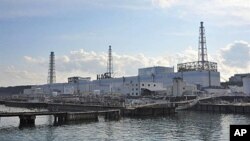Many countries are embracing nuclear power as a source of electricity. But just weeks ago, A massive earthquake in Japan caused significant damage to one of that country's nuclear power plants. While the international nuclear power industry says it is strongly focused on safety, the events at Japan's Fukushima facility raise concerns that no matter how carefully designed these nuclear facilities may be, accidents can happen.
It happened on March 11. First, Japan shook violently from an earthquake - now called the most powerful ever to hit that country. Then, immediately after, a tsunami smashed what the earthquake had not destroyed. And, in the path of both was the Fukushima nuclear power plant on the Pacific coast, north of Tokyo.
The dual disasters knocked out power needed to maintain safe cooling levels for the plant's multiple nuclear reactors. Despite emergency efforts, temperatures in the reactor cores rose to dangerous levels.
And then, the worst happened. A day after the earthquake and tsunami, the building housing one of Fukushima's reactors exploded. Two days later, another reactor building was shattered by a blast. And, a day after that, yet another explosion tore apart a third reactor building. The end result was the release of dangerous nuclear radiation, which continues at varying levels today.
Japanese officials evacuated a 20-kilometer zone around Fukushima. Nearly 500,000 people had to leave their homes. At numerous sites near the plant, people were - and still are - screened for radiation, which was also detected in places far from the scene.
And, the radiation levels at Fukushima forced officials to evacuate most plant workers for days.
Officials monitoring the Fukushima disaster are carefully monitoring the concrete and steel structures called "containment vessels" that encase the nuclear reactors. These containment vessels are designed to prevent radiation from escaping. There are concerns that at least one of the vessels at Fukushima may have been breached.
Former International Atomic Energy Agency (IAEA) Safety Director Phillipe Jamet said these structures are vitally important.
"The containment vessels are one of the barriers," said Jamet. "We have to protect the environment and people against radioactivity in case of an accident."
Roughly 25 years ago, the worst nuclear disaster in history took place at the Chernobyl nuclear plant in Ukraine. The Soviet-built plant did not have containment vessels surrounding its obsolete style of reactors.
Early on April 26, 1986, reactor Unit Four at Chernobyl overheated and exploded, tearing off the roof of the building housing it.
Nuclear radiation spewed into the night sky. And, as people slept, it spread throughout the city of Pripyat, just north of Chernobyl.
At reactor four, the nuclear fuel and the graphite surrounding it were on fire. Authorities sent helicopters to fly over the reactor to dump sand and other extinguishing materials, but it burned for days.
The wind carried radioactive particles from the fire over a wide area. Ukraine, Belarus, Russia. Then, Scandanavia, Britain, and other parts of Europe.
Radioactivity forced officials to create a 30-kilometer-wide no-habitation zone around Chernobyl, sealing off Pripyat.
Thousands of people were sent to Chernobyl to clean up debris from the blast. They also built a structure, called a sarcophagus, to cover the shattered reactor and its radioactive fuel.
Pripyat is now a dead city. Homes, schoolrooms, playgrounds, and other places are crumbling as wild nature reclaims the land. Pripyat once had some 50,000 residents. Now they are gone, perhaps forever. Only the artifacts of their lives remain behind, rotting to dust.
The Soviet government said at least 31 fatalities at the Chernobyl plant were directly linked to the reactor explosion. The World Health Organization (WHO) says another 2,200 deaths can be expected among those who took part in the cleanup. The WHO report added that, in all, Chernobyl could result in 4,000 fatalities from cancer and other radiation-linked causes.
Seven years before Chernobyl, on March 28, 1979, the critical need for reactor containment vessels was proven at the Three Mile Island nuclear power plant in the Eastern U.S. State of Pennsylvania.
A loss of reactor cooling water caused a partial meltdown of the nuclear fuel in the plant's Unit Two. But, the containment vessel remained intact and shielded the environment from the damaged core.
The Three Mile Island incident compelled the U.S. nuclear power industry to significantly toughen safety and operating standards.
"It just caused a re-examination and a need for continuous improvement in our operations - to not get complacent, to have better training, to improve our off-site response capabilities in terms of emergency planning," noted Tony Pietrangelo, Vice President at The Nuclear Energy Institute trade group.
Nuclear power operators worldwide say safety tops their priority list, and is constantly reinforced through training and monitoring of plant operations.
The same is being said by the Atomic Energy Organization of Iran, which has completed that country's first commercial power plant at Bushehr, alongside the Persian Gulf.
In coming segments of this series on nuclear safety, we will examine Bushehr in more detail. Click here for part 2 and part 3.












